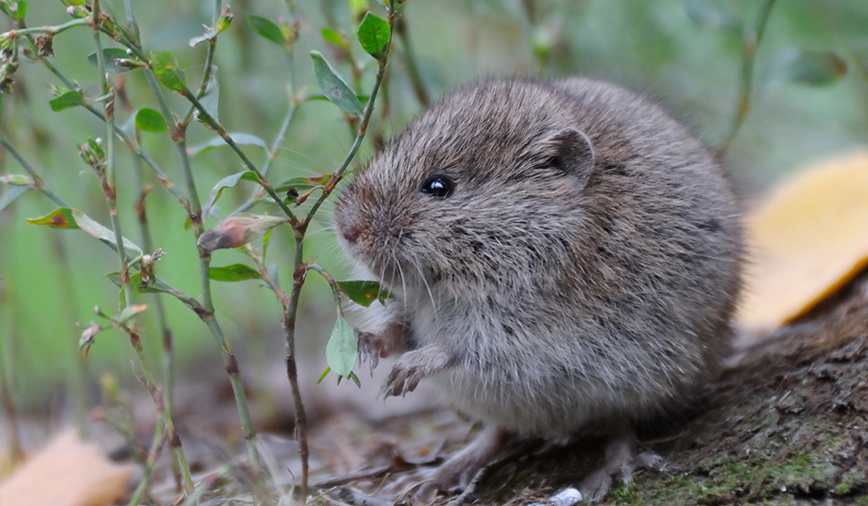Pam’s Perspective
Pam Otto is the Manager of Nature Programs and Interpretive Services for the St. Charles Park District
When was the last time you played hide and seek?
I did for the first time in a long time last Tuesday and, I tell you, I don’t ever remember the game lasting as long as that one did. I didn’t think it was ever going to end. I was “it,” and my worthy opponent was one of the best hiders I’ve come across. But I suppose that’s to be expected, when you’re playing against a vole.
Round one started early in the day, when my friend Valerie stopped by Hickory Knolls. As we were chatting, I noticed her looking past my shoulder to the adjacent workroom. “I think you’ve got a critter on the loose,”
she said, but by the time I turned my head, the creature had disappeared. Vole: 1, Me: 0.
Round two began about an hour later, when I stepped into the kitchen to grab a cup of coffee. I sensed motion down near my feet and looked just in time to see a small, dark shape scuttle under the refrigerator. Vole: 2, Me: still 0.
After lunch, it was time for round three. I was seated at our front desk and just happened to look across the lobby at the wire enclosure that houses our resident rabbit, Peter.
Petey was reclining at one end of the pen, but he uncharacteristically had company. The small, dark form was back, and it was eating Pete’s bunny chow.
I stood up and walked across the lobby, and was able to get a better look at my quarry. It was indeed a vole—probably a meadow vole, the most abundant species in our area—and it wasn’t quite ready to be caught. It scampered past my feet, again, ducked under the kitchen door and was gone. Vole: 3. Me…do I really need to say it?
Down but not out, I went back to work and decided to spend a few minutes reflecting on my rival.
Voles are common rodents in our area and frequently are mistaken for mice. But whereas a mouse is fairly sleek, with a pointy nose and a long, naked tail, a vole will be rounder and chunkier—picture a pint-sized baked potato, with fur. Its tail is shorter, half the length of the body, and has a light coat of fur on it.
Also like a baked potato, voles seem to go with everything. They serve as side dishes, and sometimes the main entrée, in the diets of just about every predator around, from hawks and owls to coyotes and foxes, even bullfrogs, snakes and largemouth bass. (Yep, voles can swim, though clearly sometimes not fast enough.)
When you’re hunted by so many different types of animals, you have to have a few built-in strategies to ensure the survival of your species and its role in the ecosystem. (Folks tend to consider voles pests, but they play an important role in habitat restoration by dispersing plant nutrients and mycorrhizae, fungi essential to healthy plant life.)
For voles, the main survival secret is their reproductive rate. Females as young as three weeks old can begin breeding, and most produce multiple litters a year.
They also are adept at staying out of sight. Meadow voles typically navigate via runways underneath tall grass in summer and below the snow in winter. (You know those trails that appear in your yard when the snow melts away in spring? They are the work of resident voles.)
(Continued on Page 2)
Pam’s Perspective – Page 2
And now I was able to witness this proficiency at hiding first hand.
I was about to admit defeat when two things happened. One, Miss Amber of Animal Intuitions, who teaches dog obedience at the park district, arrived and began setting up for her evening class. Two, perhaps due to her keen animal intuition, she spotted the vole almost immediately.
In a bold move, it had headed back to Peter’s food bowl. There it sat, munching contentedly, now completely confident in its ability to outsmart the big lout in the Hickory Knolls shirt.
Ah, but this time I had two factors working for me. One was Amber, who could keep an eye on the little guy and direct its scurrying with her foot. The other was a plastic cup, just large enough to scoop up a vole.
After a bit more scurrying, more on my part than the vole’s, the little critter was contained. A few short minutes later, it disappeared once again, into the tall grasses of the savanna outside. Vole: 3, Me: 1. Or is that “won”?
Pam Otto is the manager of nature programs and interpretive services for the St. Charles Park District. She sometimes hides, often seeks, and always can be reached at potto@stcparks.org or 630-513-4346.

